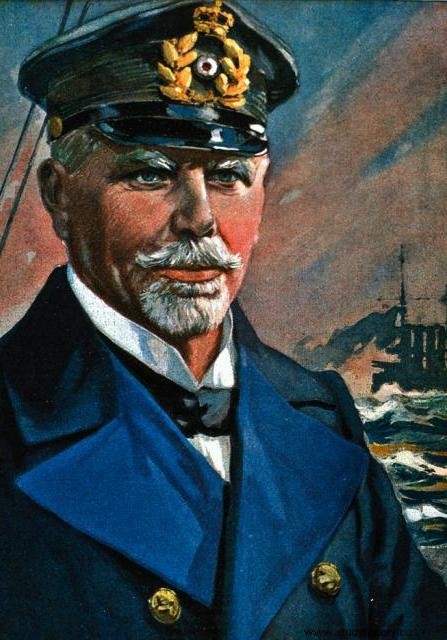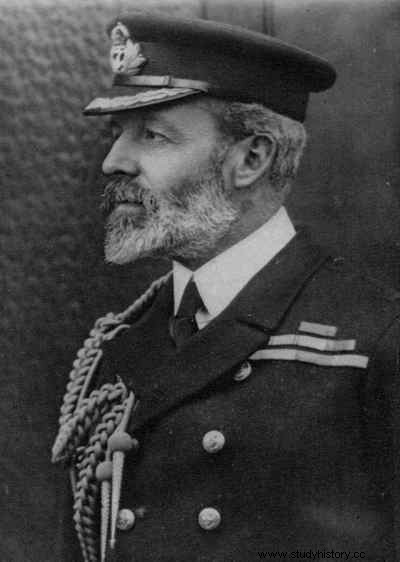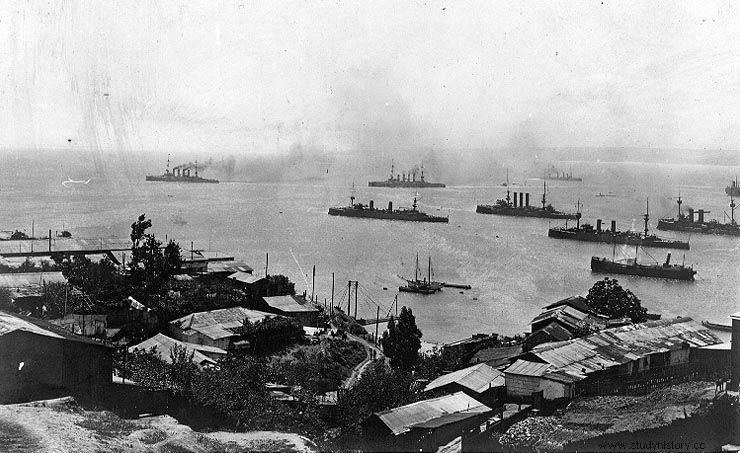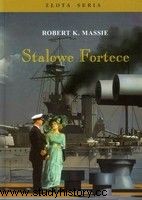When World War I broke out, the position of the Royal Navy seemed unwavering. No one has defeated the British in open combat at sea for over a century. The German Vice Admiral von Spee decided to show that it was possible.
In the late nineteenth century, the young German state, eager for territory and influence, seized the first colonial footholds in Asia. Adequate naval forces were needed to protect them, and therefore the East Asian Squadron was created. On the eve of the Great War, it consisted of six warships. The largest of them were the twin armored cruisers SMS "Scharnhorst" and SMS "Gneisenau". They were supported by four light cruisers:SMS "Nürnberg", SMS "Leipzig", SMS "Dresden" and SMS "Emden". The entire formation was led by the brilliant graph Maximilian von Spee.
South America direction
As Robert K. Massie emphasizes in his book "Steel Fortresses", the German vice admiral realized very quickly that his ships had no chance against the British in the Asian theater of operations. Therefore, he decided that the only "Emden" would remain in the Indian Rating - as a raider, and therefore a ship intended to disrupt the enemy's actions. The rest of the units moved towards South America in August 1914, from there to break through to Europe.

The commander of the East Asian Squadron, Vice Admiral Count Maximilian von Spee (source:public domain).
At first everything went as planned and the Royal Navy was unable to locate Count von Spee's forces. That changed in October, when the British finally realized what the German admiral was planning. The West Indian Squadron under the command of Rear Admiral Christopher Cradock was sent to intercept it.
Squadron forces definitely did not match its pompous name. Its core was made up of two heavily obsolete armored cruisers:the flagship HMS "Good Hope" and the HMS "Monmouth". They were supported by the light cruiser HMS Glasgow and the auxiliary cruiser Otranto (an armed transport vessel).
Of the four, only HMS Glasgow was a ship of that standard. Nevertheless, its firepower was no match for that of the "Scharnhorst" and the "Gneisenau".

West Indian Squadron Commander Rear Admiral Christopher Cradock (source:public domain).
Churchill says no!
Cradock was well aware of the weakness of his forces. He demanded that his formation be reinforced with a modern armored cruiser HMS Defense. However, Winston Churchill did not agree to this who was the First Lord of the Admiralty at the time. Instead, the antiquated battleship HMS Canopus was co-opted into the West Indian Squadron. It had two 305 mm guns, but it was far too slow to take part in the search for German ships.
Therefore, Cradock decided to go into action with only four units, which, to make matters worse, were technically inferior to von Spee's forces. In this situation, the role of the scout fell to HMS "Glasgow", who called on October 31 at the Chilean port of Coronel. There he was spotted by the crew of the vessel "Göttingen", which was supplying supplies for von Spee.
According to international law, the British vessel could only stay in the port for 24 hours, otherwise it would break the principles of Chilean neutrality. Therefore - as Robert K. Massie writes in "Steel Fortresses" - the German admiral decided to trap and destroy this relatively small enemy.

HMS Good Hope flagship of the West Indian Squadron Rear Admiral Christopher Cradock. Image by William Lionel Wyllie (source:public domain).
Meanwhile, the British intercepted radio signals from the light cruiser SMS Leipzig. Admiral Cradock, believing that the Leipzig was sailing alone, chased after it. It never occurred to him that he would face a tough battle with two armored cruisers and three light cruisers.
And that's just a surprise
The enemy forces met on November 1, 1914 around 4.30 pm. As Massie notes both admirals were surprised because each thought they were approaching a single enemy light cruiser. Despite the advantage on the side of the German ships, Christopher Cradock did not decide to escape. This would be tantamount to leaving the slow "Otranto" to the prey of the opponent.
Cradock was also convinced that he had a chance of winning after all. His ships were located between the enemy and the setting sun, which blinded the German sailors. In this situation, the British admiral tried to clash at all costs. Meanwhile, Maximilian von Spee, having the advantage of speed, delayed the confrontation until the sun was below the horizon. When this happened, the black silhouettes of British ships against an orange sky became an ideal target for highly trained German artillerymen.

Duck shooting
The first shots from the 210 mm guns of Scharnhorst and Gneisenau were fired shortly after 7.00 p.m. Although the sea was very rough that afternoon, only three volleys of the Scharnhorst were enough and Cradock's flagship was hit and burst into flames. The loss of one of the 234 mm guns was especially painful for the British. The artillerymen from "Gneisenau" were doing just as well. They quickly hit the HMS Monmouth by hitting the fore deck.
Despite severe damage, British armored cruisers were forced to get even closer to the Germans. All because of the outdated on-board artillery, which had a much shorter range than that mounted on enemy ships. As a result, "Good Hope" and "Monmouth" collected another murderous hits. The first one at 7.42pm , wanting to sell the leather dearly, gathered all the remaining strength and headed straight for his torturers, dragging a cloud of flames behind him.
This desperate attempt to attack, however, failed, only hastened the inevitable. Now both German armored cruisers were firing on Admiral Cradock's flagship. Finally, at 7.50 pm, the air was shaken by a monstrous explosion, which resulted in the detachment of the prow of the Good Hope. Moments later the ship sank.

The Battle of Coronel on a German postcard from the Great War period (source:public domain).
At that time, the Monmouth was also in a deplorable state, drawing water and completely unfit for further combat. It ended shortly before 10pm, when - after its crew refused to surrender - he was literally shot at close range by "Scharnhorst" and "Gneisenau".
However, Glasgow was more lucky, as it received five hits against the German light cruisers, but only one of them caused more serious losses. Thanks to this, he was able to withdraw in time. As for the "Otranto", its captain at the beginning of the match decided that he had no chance in direct battle with the Germans and sailed away to a safe place.
This blood insult requires
The Battle of Coronel, which lasted only a few dozen minutes, turned out to be a painful defeat for the Royal Navy. Two armored cruisers went to the bottom, taking with them nearly 1,600 officers and sailors. Among them was Admiral Christopher Cradock, who had repeatedly said before that he dreamed of dying in combat.

Admiral von Spee's ships leave the Chilean port of Valparaiso. The photo was taken a few days after the Battle of Coronel. At the front (four-chimneys) "Scharnhorst" and "Gneisenau" (source:public domain).
In turn, the German ships were hit by a total of only seven missiles, which did not cause any serious damage. There were also no fatalities, only three sailors suffered minor wounds.
The Royal Navy headquarters had to wash away this disgrace. For this purpose, a strong team was formed, led by Admiral Frederick Sturdee. His goal was to annihilate Admiral Spee's squadron. This happened on December 8, 1914, during the Battle of the Falklands. But that's a story for a completely different article.
Sources:
Basic:
- Robert K. Massie, Steel Fortresses , vol. 1, Finna 2014.
Complementary:
- Jan Gozdawa-Gołębiowski, Tadeusz Wywerka-Prekurat, World War I at Sea , Morskie Publishing House 1973.
- Stanisław Strumph Wojtkiewicz, Corsairs of William II, Publishing house MON 1965.
We recommend:
 Steel Fortresses - The First World War at Sea in the masterful narrative of Robert Massie, the Pulitzer Prize winner. The author brilliantly draws the main characters of events - from royal courts through members of governments to commanders of fleets and individual ships involved in the most important events of the First World War. The author, as in "Dreadnot" published a few years ago, does not spare the reader many anecdotal stories, thanks to which his story can be read in one breath.
Steel Fortresses - The First World War at Sea in the masterful narrative of Robert Massie, the Pulitzer Prize winner. The author brilliantly draws the main characters of events - from royal courts through members of governments to commanders of fleets and individual ships involved in the most important events of the First World War. The author, as in "Dreadnot" published a few years ago, does not spare the reader many anecdotal stories, thanks to which his story can be read in one breath.
